I’m very excited to introduce a delicious new member to my Bao collection on the blog: baked bao bun with lamb filling. They are intensely flavoured with spices and baked to perfection. Follow my detailed instructions and tutorial video to make them!
Inspired by northwestern specialities
Growing up in northwest China where halal food is popular, I’m a big fan of spiced lamb dishes. One of my favourite street foods is Xinjiang style baked buns (Kao Bao Zi, 烤包子). Fatty lamb cubes enveloped with unleavened dough into pillow shape and baked in a tandoori oven, they are super tasty and comforting!
On my Culinary Tours of China, I discovered another type of baked lamb bao bun in Lanzhou. They are filled with minced lamb & carrot, wrapped with yeast dough and shaped into regular bao pattern. My tour participants and I enjoyed them a lot.
Inspired by these two regional specialities and my beloved Lamb Skewers, I’ve developed my own baked lamb bao bun recipe that I’m very proud to share with you. The wrapper is fluffy inside and crunchy outside. The lamb filling is moist and intensely flavoured. So scrumptious!
Summary of the cooking procedure
Before we dive into the detailed cooking tips & tricks, let me summarise the cooking steps involved in producing delicious baked bao bun.
- Marinate the lamb with seasonings & spices.
- Fry onion & carrot in lamb fat with more spices. Mix with the lamb once cooled down.
- Prepare the dough then straight into rolling the wrappers and assembling the buns.
- Rest the buns for 30 mins then bake in the oven for about 20 mins until golden.
How to make a delicious lamb filling
I’ve tested the filling for this baked bao bun recipe a number of times. Eventually, I’ve found the “perfect” formula that I’m super satisfied with. The flavour and texture are spot on!
- I use raw, small cubes of lamb so it stays moist and tender after baking.
- For the vegetables, I fry onion and carrot in lamb fat to bring out their sweetness and extract the excess liquid.
- In terms of seasoning, I use a combination of cumin powder and cumin seeds to highlight this best pairing spice for lamb. A spoonful of chilli flakes is also added to give the filling an extra kick.
Cut & marinate the lamb
I like lamb leg for this recipe as it’s a tasty cut and contains a reasonable amount of fat. Chinese dumplings and stuffed buns usually call for minced (ground) meat. For these baked lamb bao buns, I use diced lamb instead. This way, more moisture is retained in the meat. Also, it provides a nice bite. However, please feel free to use minced lamb if you wish.
Cutting meat into small cubes can be a messy, time-consuming job. Here are my tips to make it easier.
- Always sharpen your knife before cutting.
- It’s much easier to cut a firm piece of meat so freeze the lamb for 1-2 hours beforehand until it turns semi-frozen.
- Cut the lamb into strips then turn 90 degrees to dice.
- Prepare a big batch then bag it into small portions for later use. So the next few times when you make this dish, simply defrost a bagful.

To marinate the lamb, you will need cumin powder, dark soy sauce, sesame oil, salt, corn starch & water. Mix until all the liquid is fully absorbed by the meat. If your kitchen is quite warm, refrigerate while preparing other ingredients. Otherwise, you can leave it on the counter.
Fry the vegetables
For frying the vegetables, I use lamb fat that is trimmed off the lamb leg. It adds a rich flavour to the filling. Cut it into small pieces then fry over low heat until oil appears and the pieces turn brown. You may either keep the remaining pieces in the filling or discard them.
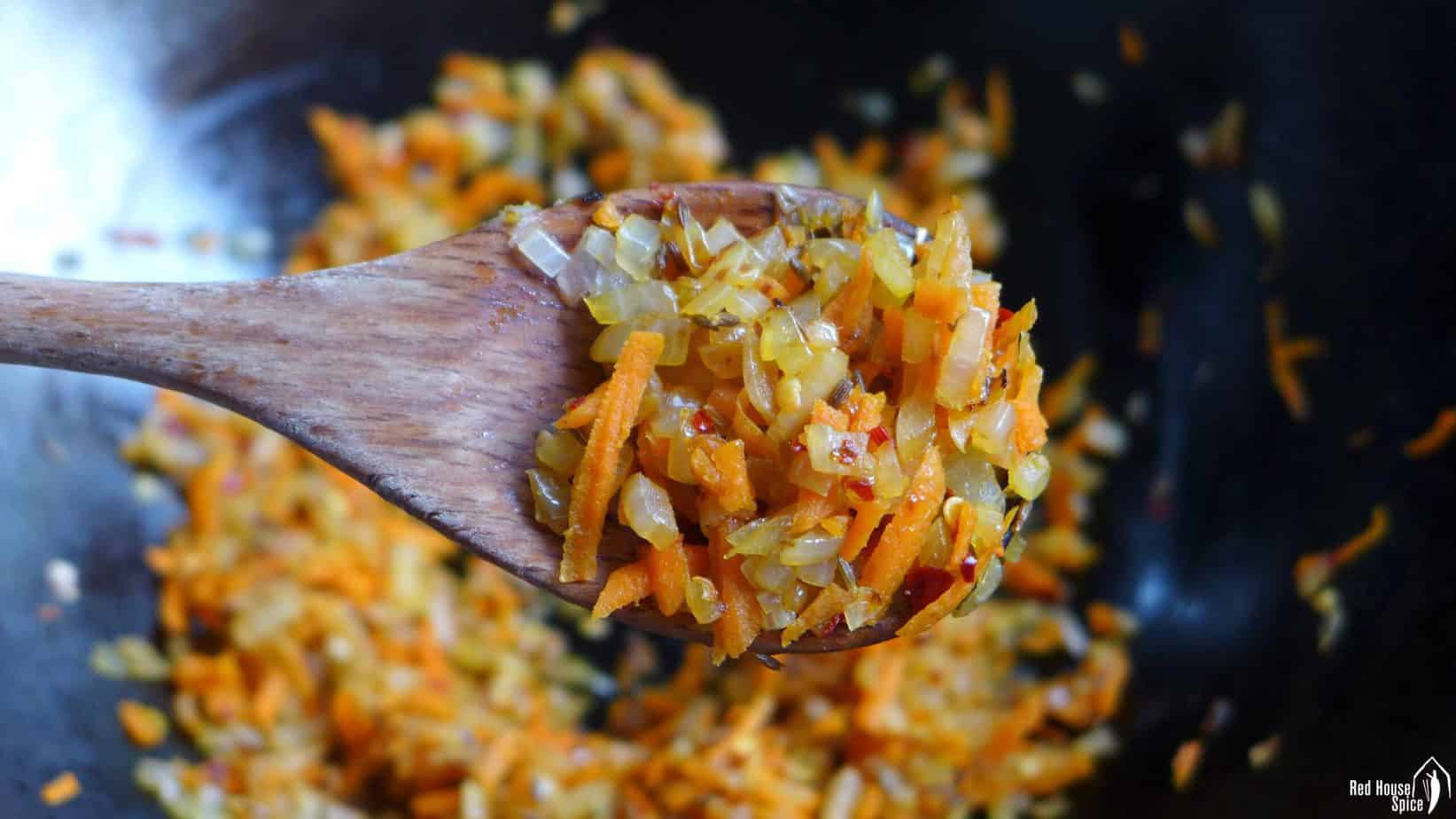
Firstly add finely chopped onion. Fry until it gains a nice caramelised look. Then add cumin seeds, chilli flakes and grated carrot. Dish out when the carrot wilts. Mix with the marinated lamb once cooled down.
A quick & easy dough recipe
I use a quick & easy leavened dough for my baked bao bun (same as the dough I use for Steamed Plain Buns and Scallion Flower Rolls). No lengthened kneading or extended resting required so it’s perfect for novice bakers. For making 12 medium-sized bao buns, you would need:
- 250 g all-purpose flour (aka plain flour)
- 1 teaspoon instant dry yeast
- ¾ teaspoon baking powder
- 1 teaspoon sugar
- 130 ml lukewarm water
In terms of leavening agent, the traditional bao buns dough calls for yeast only. It requires two sessions of resting: one before assembling the buns, another afterwards. My easy dough recipe includes baking powder which makes the proofing process less time-consuming (and no guessing game about “if the dough has doubled in size”). Here are two simple steps to follow:
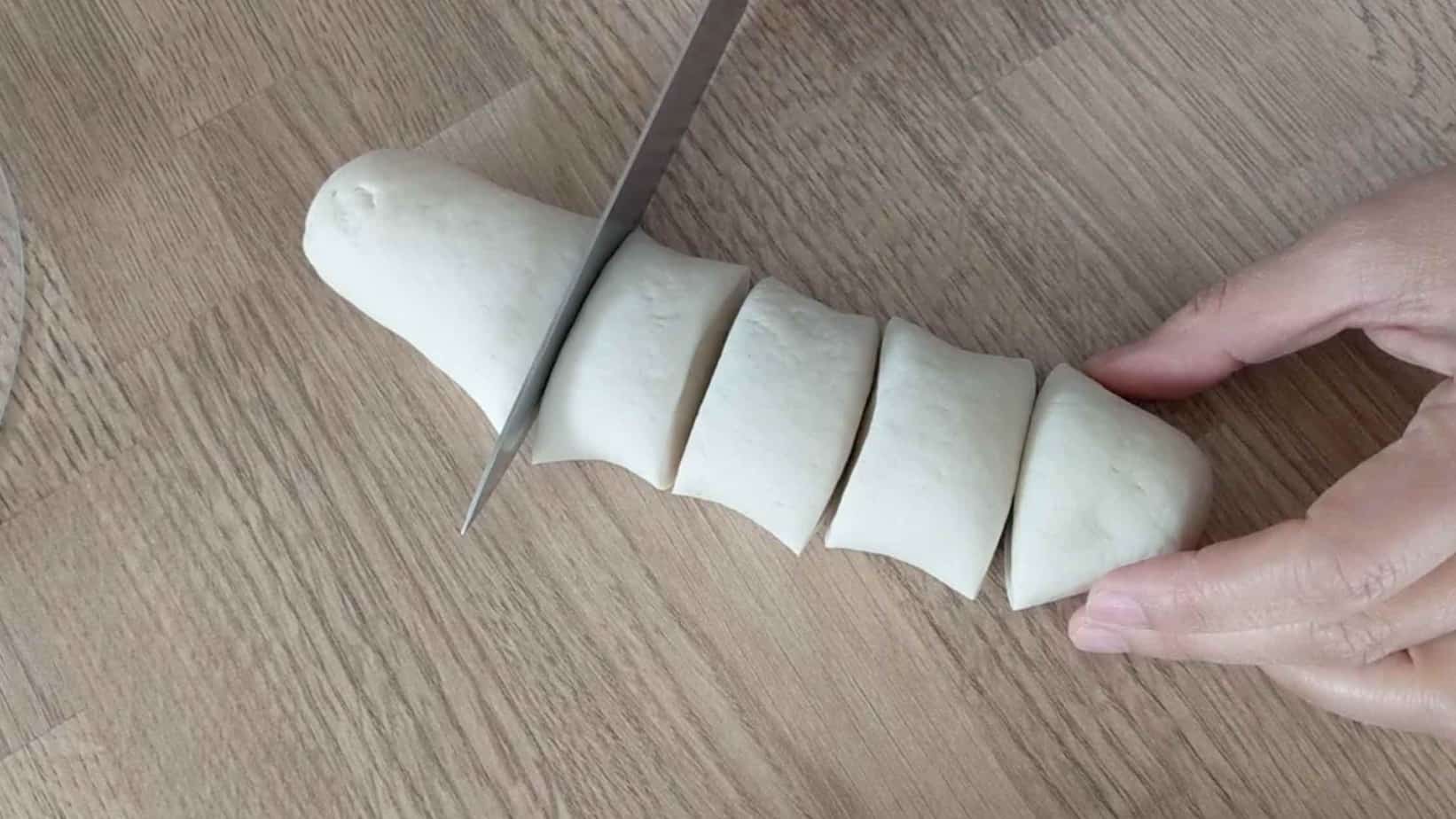
- Mix all the ingredients and knead to form a smooth dough. Start rolling the wrappers and shaping the buns right away.
- Leave the buns to rest for about 30 mins then they are ready to be baked.
Kneading isn’t complicated for this recipe. Once all the ingredients are well combined and the dough becomes smooth, you are done.
- If you have a stand mixer with a dough hook attachment, simply knead all the ingredients on low speed for about 8 minutes.
- If you are kneading by hand, use my favourite “resting trick”: after combining all the ingredient into a rough-looking dough, leave it to rest for 10 minutes (covered) then knead again. It will take just a couple of minutes to make it smooth.
How to assemble the bao buns
Now let’s talk about the most fun (or intimidating) part of bao bun making: rolling the dough into round wrappers then stuffing them with filling and pleating into beautiful buns! It does take some practice to make good-looking ones. But the great news is no matter how ordinary your bao buns look, they will taste good!
Make the wrappers: roll & turn
After dividing the dough into equal sections, you roll each piece into a round disc, about 12 cm in diameter. I’ve introduced the “roll & turn” technique in all my dumpling and bao recipes:
Hold the dough with one hand and move the rolling pin with the other hand. Roll forward to the centre and come back. Then turn the wrapper a little. Keep repeating the roll and turn motion until the wrapper gains the desired look: thin on the edge and slightly thicker in the middle. My tutorial video in the recipe card below shows you how I do it.

To make the process a little easier, follow a few tips:
- Dust the work surface and the rolling pin with a little flour if the dough sticks.
- Always cover the unused dough to avoid drying out. This is particularly important if your kitchen is hot & dry.
- Use a Chines style slim rolling pin which is no bigger than 3cm in diameter. They are usually available in Asian/Chinese shops or some mainstream online shopping platforms.
Pleat the buns: feel free to improvise
It’s quite hard to explain how a bao bun is pleated. So if this is new to you, head over to my tutorial video (in the recipe card below) to see my technique. My images show the traditional look of a Chinese bao bun (baozi, 包子), but please feel free to fold your ones the way you feel most comfortable with.
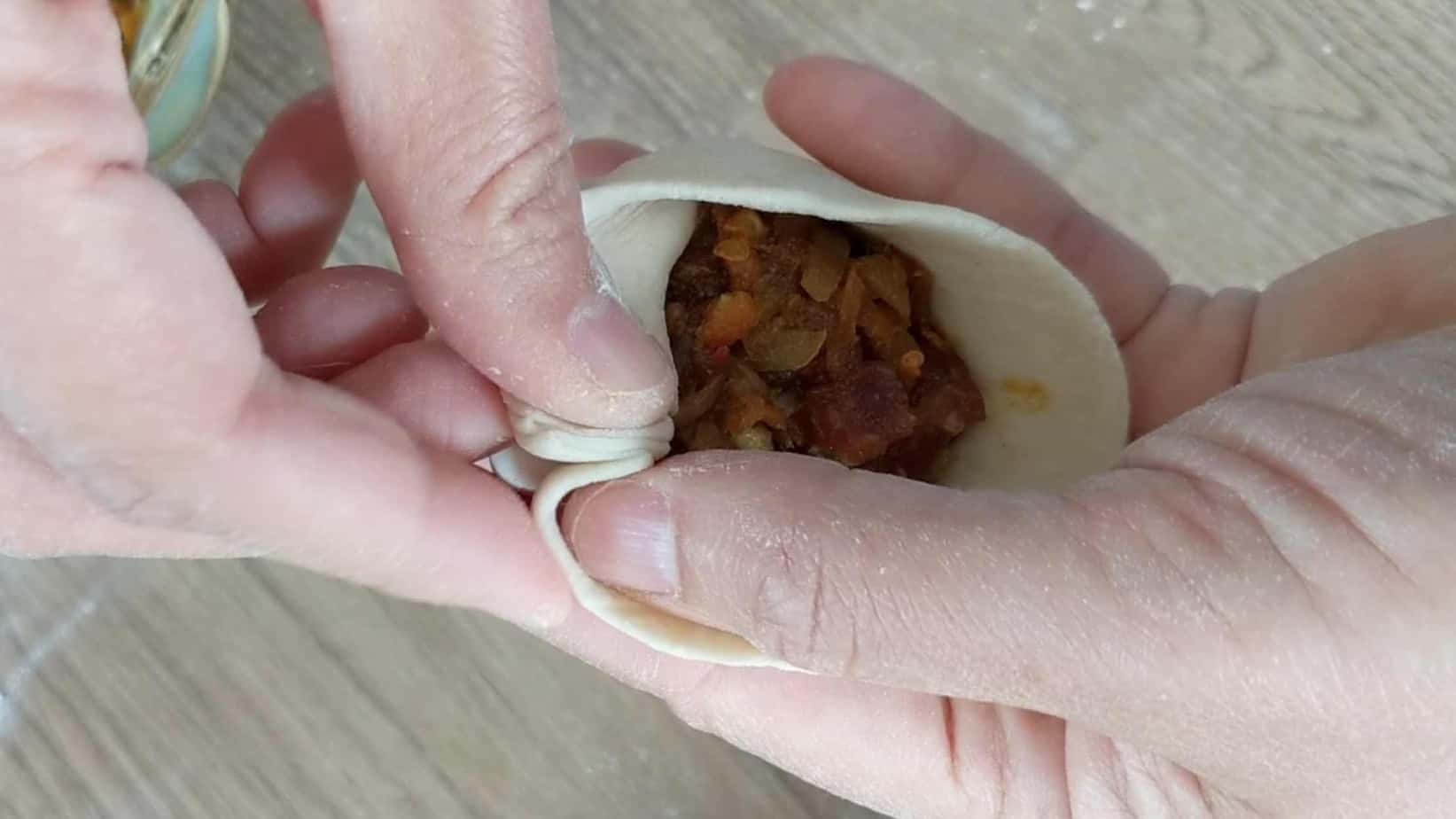
- If you don’t think your buns look as pretty as expected, you can place them upside down to bake (make sure the wrappers are completely sealed). This way you have the round, smooth side on the top. Very nice too!
- Another solution is to seal the buns in other ways. I’ve shared a Guide on Dumpling Folding which includes ten different methods. You can use any of them to pleat your baked bao buns. For example, a half-moon dumpling-like bun works perfectly.
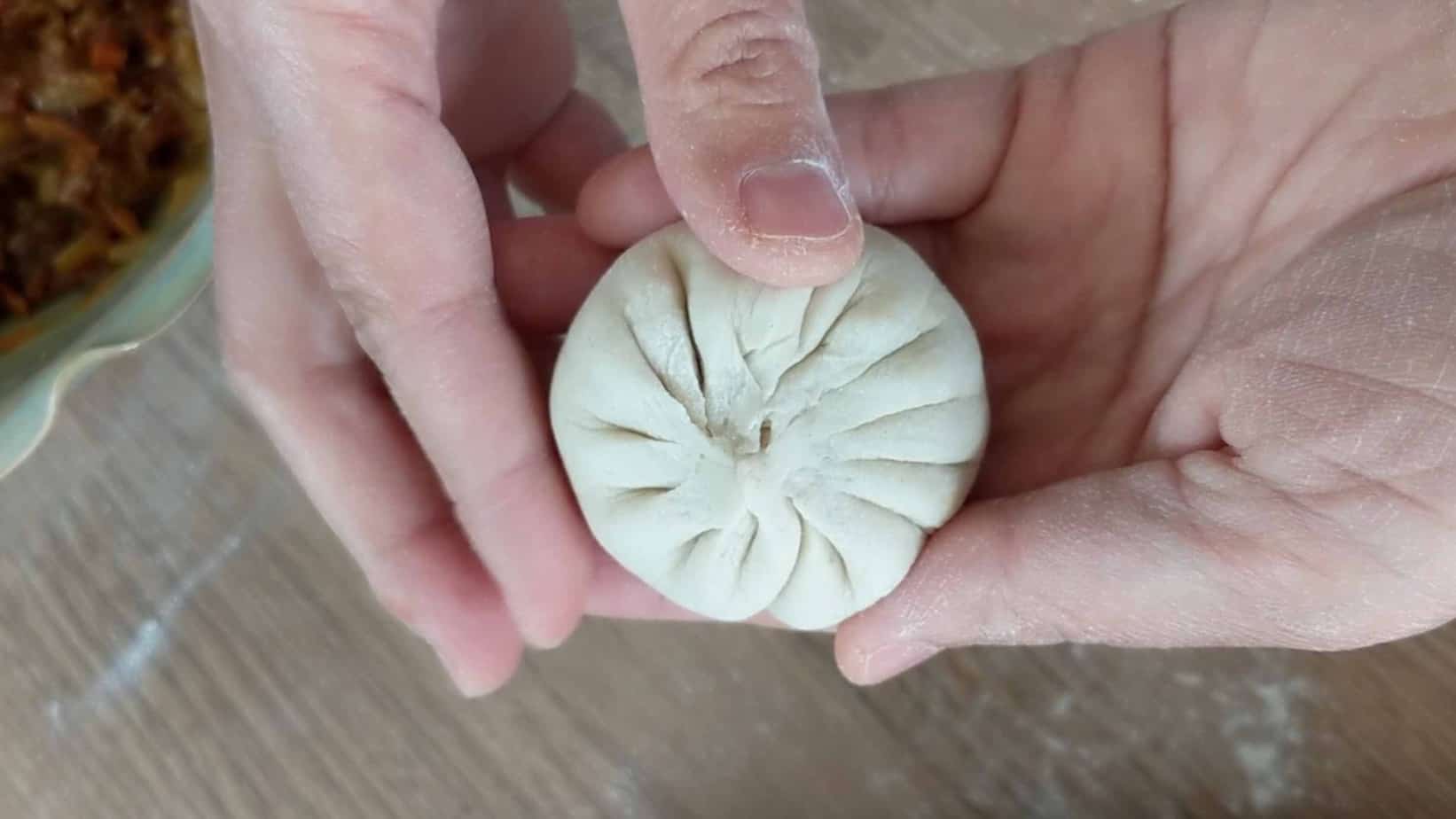
No matter how you fold your buns, please follow two simple rules for best results: 1. Make sure the filling, which becomes juicy after cooking, doesn’t leak out. 2. Avoid the dough gathering at one spot thus becoming too thick to cook through.
Bake the bao buns to perfection
Once your bao buns are assembled, place them into a baking tray (brush some oil or line with parchment paper if it isn’t non-stick). Leave to rest before baking. It takes me 30 minutes in a room at about 25°C/77°F. So if it’s cooler in yours, extend the time a little and vice versa.
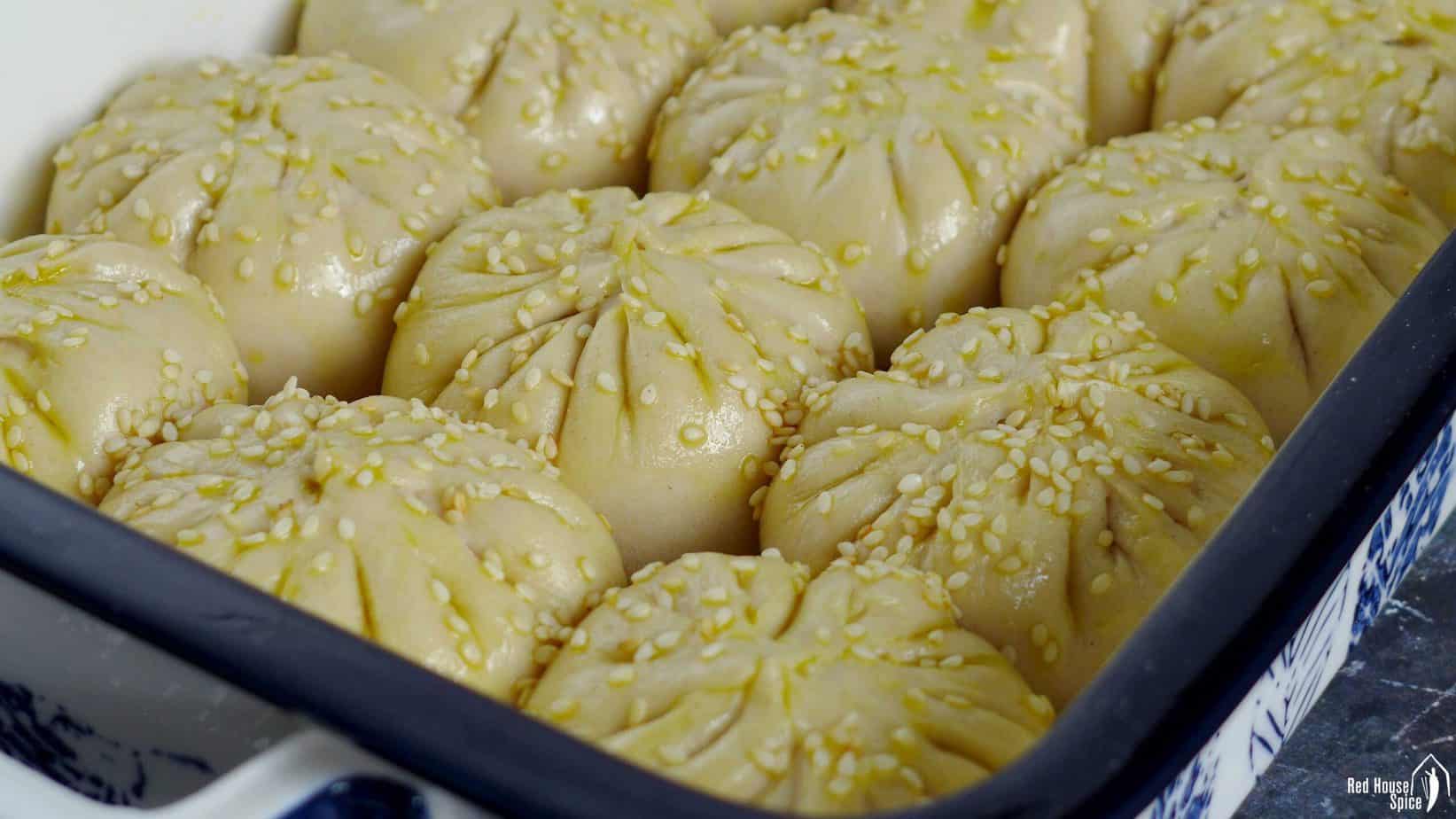
After resting, the buns will expand a little (but won’t double in size) and they look smoother and fuller. Before you pop them into the oven, brush a thin layer of oil (any type) on top of the buns then sprinkle with sesame seeds. It takes two steps to bake these bao buns to perfection:
- Preheat oven at 410°F/210°C/Fan 190°C. Place the baking tray on the middle rack. Cook for 18 mins.
- Then turn the heat up to 480°F/250°C/Fan 230°C. Cook for a further 3-5 mins until golden.
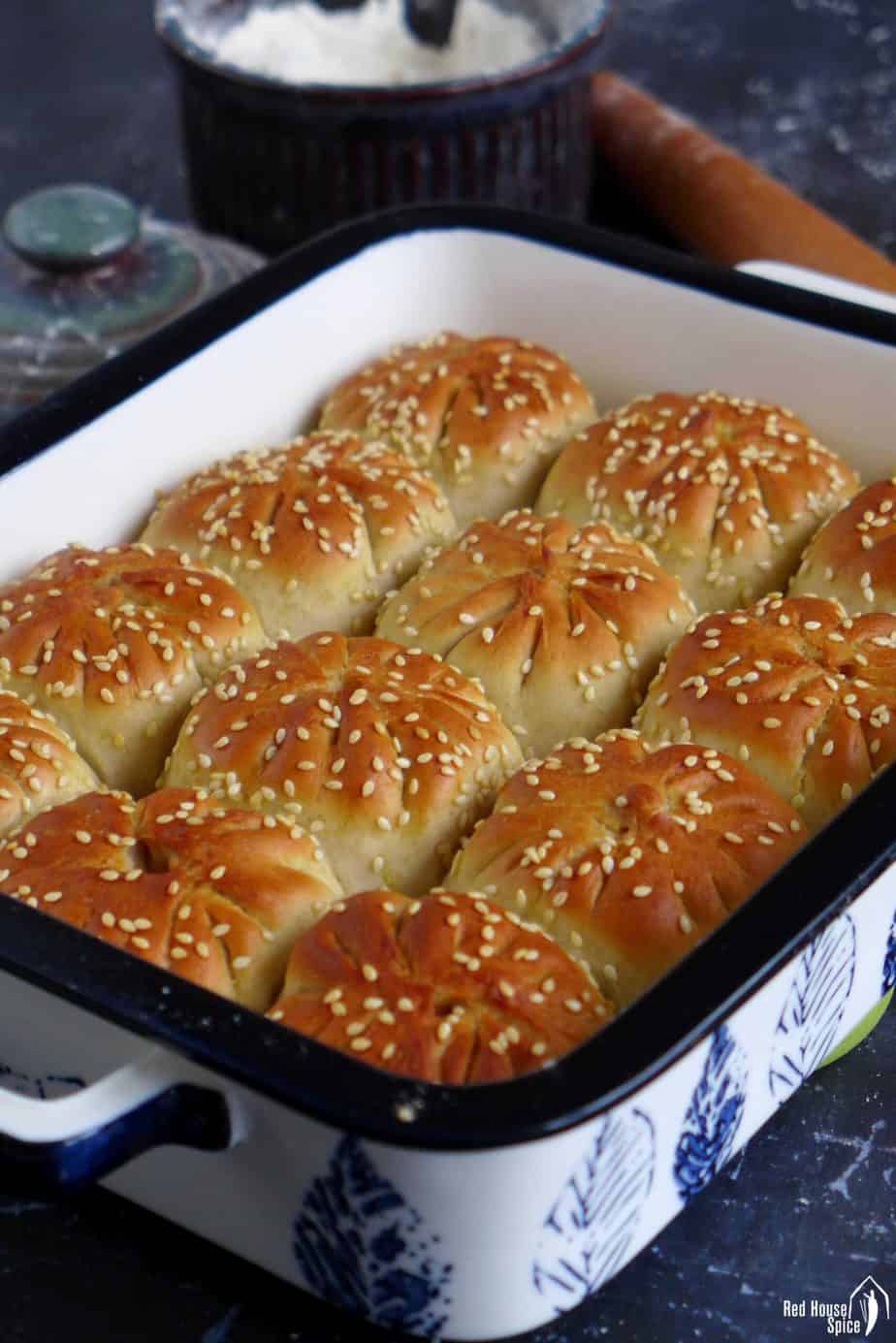
If this is your first time making baked bao bun, be attentive during the final few minutes to avoid burning. Different ovens perform slightly differently, so please feel free to adjust the time if necessary.
Recipe FAQs
A: You don’t have to. All-purpose flour which has a medium level of gluten works perfectly for this recipe.
A: Flour from different brands has different water absorption capacity. The room humidity also affects how flour absorbs water. Please feel free to make adjustments if necessary. The finished dough should be medium-firm and not sticky. You can get a sense of the right consistency in my tutorial video (in the recipe card below).
A: For dough recipes, I prefer not to provide flour measurement by cup as it’s much less accurate than measuring by weight. This will affect the flour-water ratio thus the dough consistency. If you don’t have a kitchen scale, you can do some conversion and make the necessary adjustment to achieve the desired firmness of the dough.
A: As I explained above, you should try the “10-minute-rest” trick. After forming a rough dough, leave it to rest for a while then knead again. It will become much easier to work with.
A: You can use a tradition dough recipe instead which doesn’t require baking powder. Please find instructions in my post “Steamed Bao Bun, A Complete Guide”.
A: Yes, you can. If using active dry yeast, dissolve it in lukewarm water before mixing with other ingredients. Shop bought fresh yeast cubes or homemade sourdough starter works well too.
A: Two possible reasons: 1. You’ve dusted too much flour on the wrapper. 2. The edge of the wrapper has been wet by the filing.
A: Yes! You can steam them using my method for “Steamed Bao Buns” or fry them using my method for “Shanghai Pan-fried Pork Buns (Sheng Jian Bao)”.
A: Absolutely! You can fill them with homemade Char Siu(Chinese BBQ Pork). Also, I have a guide on “How to make tasty dumpling fillings” which include four filling recipes. They work for bao buns too.
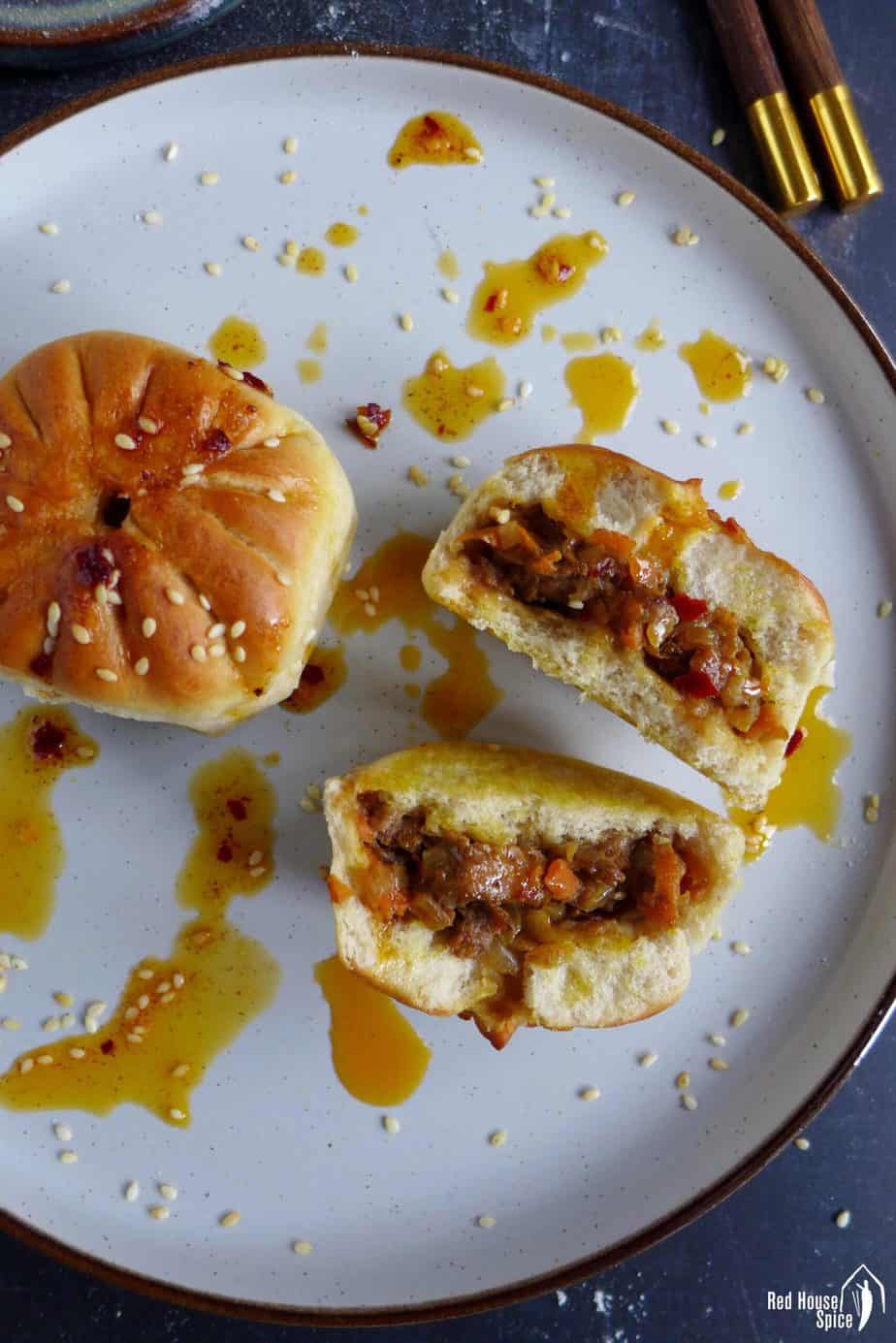
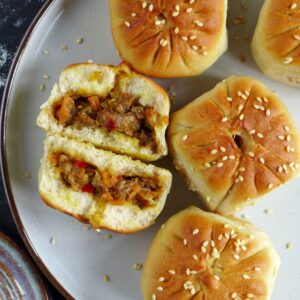
Baked Bao Bun with Lamb Filling (羊肉烤包子)
Ingredients
For the lamb
- 150 g lamb, diced - see note 1
- 1½ teaspoon cumin powder
- ½ teaspoon dark soy sauce
- ½ teaspoon sesame oil
- ¼ teaspoon salt
- 1 teaspoon cornstarch
- 3 tablespoon water
For the vegetables
- 30 g lamb fat, diced - or 1 tablespoon cooking oil, see note 2
- 2 medium onion, finely chopped
- 1 teaspoon cumin seeds
- 1 teaspoon chilli flakes
- 1 small carrot, grated
For the wrappers
- 250 g all-purpose/plain flour - see note 3
- 1 teaspoon instant dry yeast - see note 4
- ¾ teaspoon baking powder
- 1 teaspoon sugar
- 130 ml lukewarm water - adjust a little if necessary, see note 5
You also need
- ½ tablespoon cooking oil
- Sesame seeds
Instructions
Marinate the lamb
- Put diced lamb into a bowl. Add cumin powder, dark soy sauce, sesame oil, salt, cornstarch and water. Mix until no liquid can be seen.
Fry the vegetables
- Cook diced lamb fat in a wok over low heat until oil appears and the pieces brown. Discard them and keep the oil.
- Stir in onion. Fry until it slightly browns.
- Add cumin seeds, chilli flakes and carrot. Fry for one minute or so.
- Transfer to a plate to cool. Then mix with the marinated lamb. Set aside.
Prepare the dough
- If kneading with a stand mixer: Add flour, yeast, baking powder, sugar and water to the bowl. Knead on low speed until a very smooth dough forms (about 8 minutes).
- If kneading by hand: Mix flour, yeast, baking powder and sugar. Add water gradually. Mix with chopsticks/spatula until no more loose flour can be seen. Combine and knead briefly into a dough. Leave to rest for 10 minutes (covered). Knead again until very smooth.
Assemble the buns (please refer to my tutorial video below)
- Divide the dough into 12 equal pieces. Roll each piece into a disk-like wrapper.
- Place a spoonful of filling in the middle of a wrapper then fold into a bao shape.
- Place assembled bao buns into a baking tray (Brushed with a thin layer of oil or lined with parchment paper).
- Leave to rest for 30 minutes until they expand a little (see note 6).
- Brush a thin layer of oil on the buns. Sprinkle sesame seeds over.
Bake the buns
- Preheat oven at 410°F/210°C/Fan 190°C. Place the baking tray on the middle rack. Cook for 18 mins.
- Then turn the heat up to 480°F/250°C/Fan 230°C. Cook for a further 3-5 mins. If you’re making these buns for the first time, be attentive not to burn them. Please feel free to adjust the time if necessary as different ovens perform slightly differently.
Video
NOTES
NUTRITION
NUTRITION DISCLOSURE: Nutritional information on this website is provided as a courtesy to readers. It should be considered estimates. Please use your own brand nutritional values or your preferred nutrition calculator to double check against our estimates.


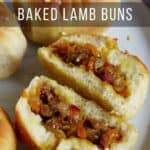
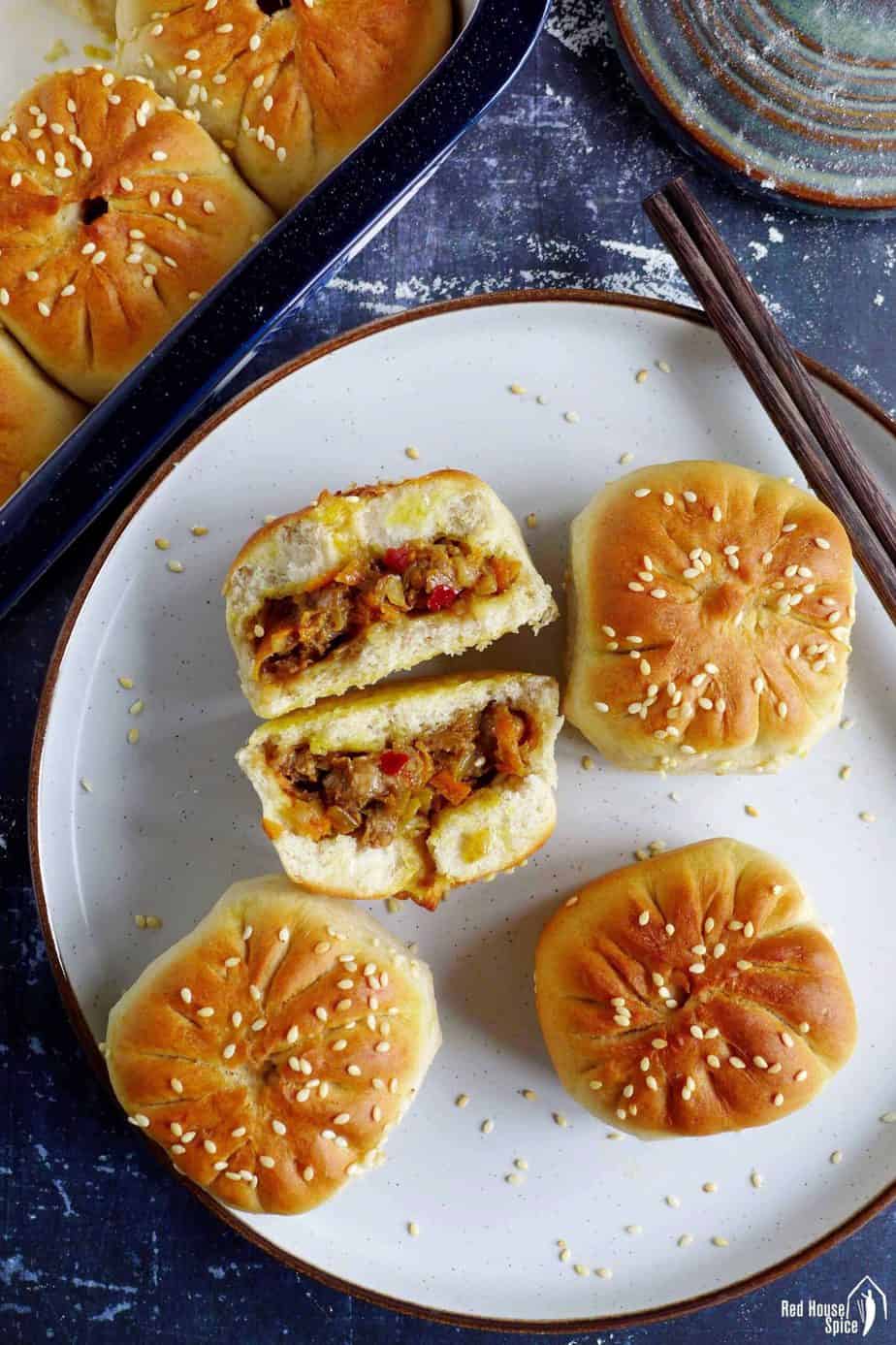
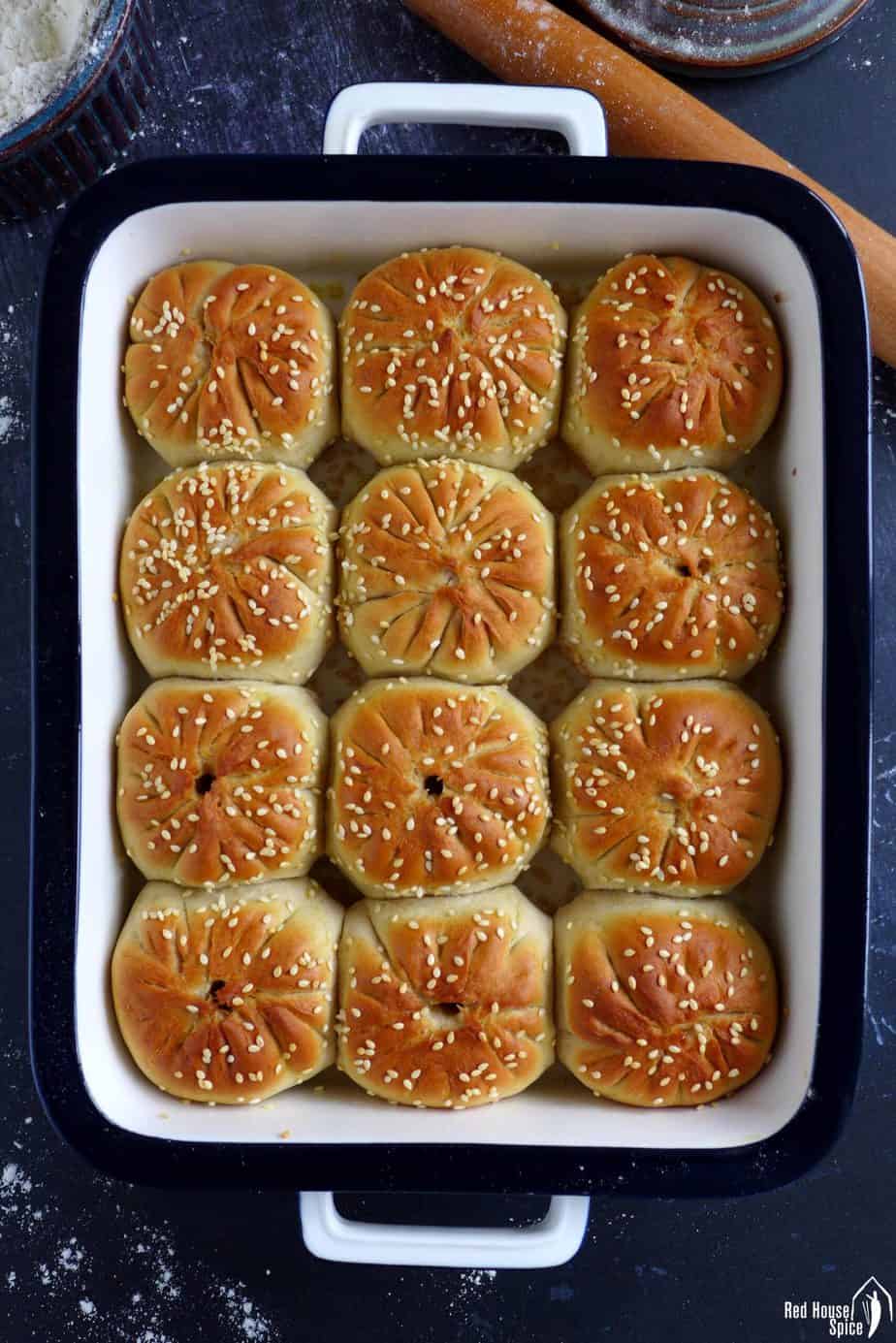
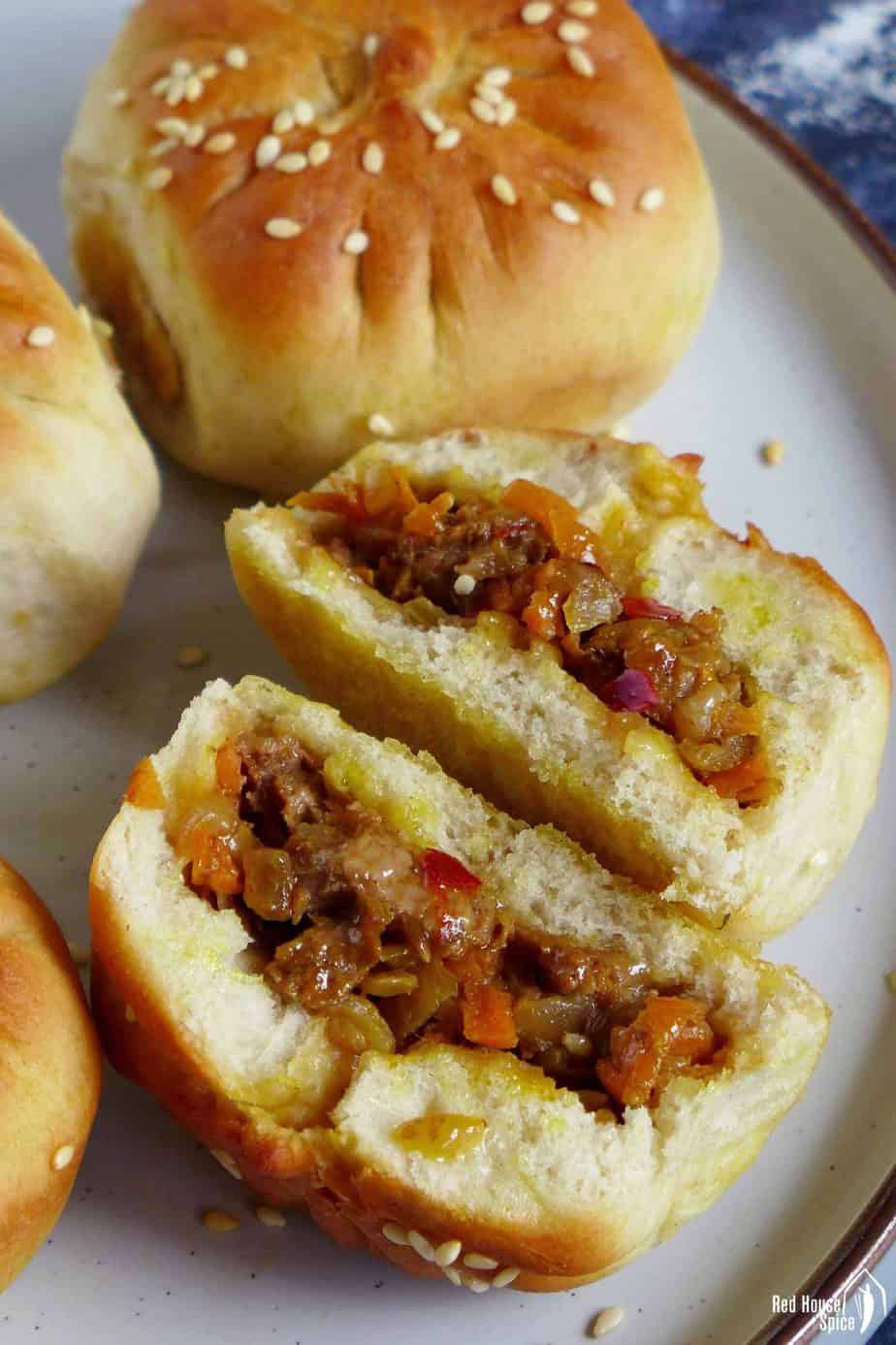
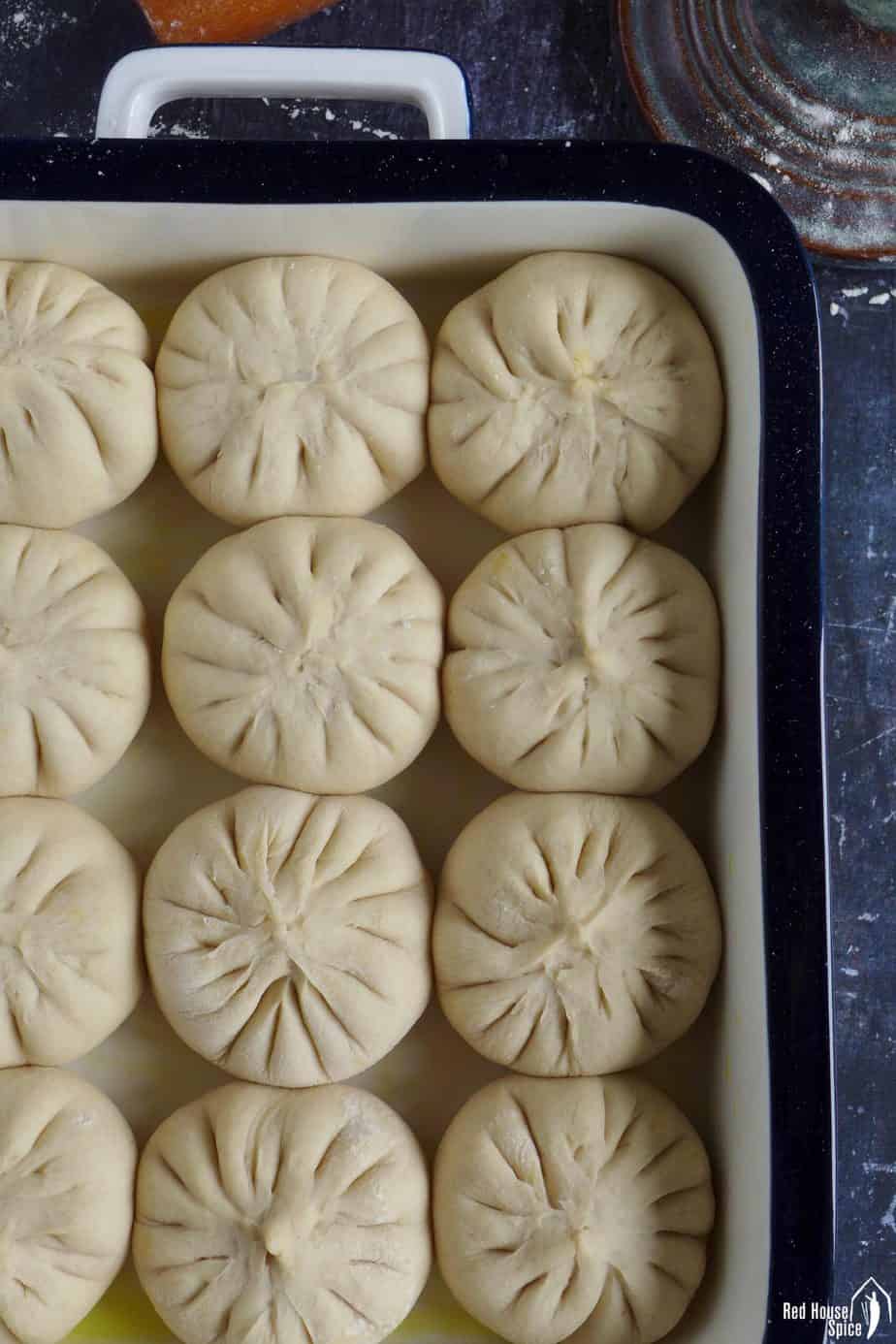
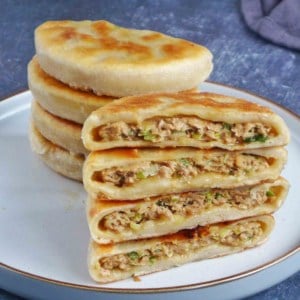
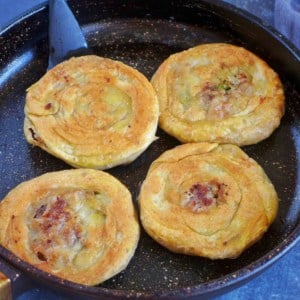
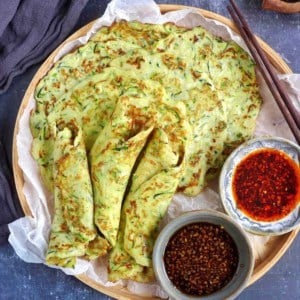
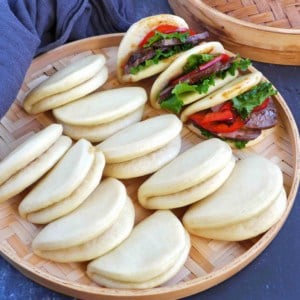
I made this recipe before with plain flour as directed and it was delicious! I only have bread flour but I dug this recipe up as I remember it being delicious – could I use bread flour for this? Or do you reccomend only using plain flour?
Yes, you can use bread flour too. You’ll need a little more water for the dough and the end result will be a little chewier.
I have now cooked your Baked Bao Buns with lamb twice. Last week I got closer to a good dough! I have found them a good main and an excellent entree.
I am girding myself up to steam them rather than bake them1
I have found that I can prepare the lamb and the vegetable components the night before, which means I can concentrate on the dough when I am assembling them!
I also have arthritis in my hands so hand-forming of the bao is not a goer. The nice thing about the rolled discs is that they are elastic. Spooning the filling into the dough disc on the bench and then drawing it up and pleating it with my fingers creates something that looks like yours!
The lamb baked bao buns were superb. Cooked to recipe instructions. i’ve just got to get better at making the dough! The “par-freeze/slice/dice” advice makes that process really easy. The taste of the filling was yummy. The Home-made Chilli Oil made using your recipe a few weeks ago was a lovely condiment for them.
Thanks Wei
If I use the chopped lamb filling and I want to just steam them instead of baking, should I precook the filling first?
You don’t need to precook the lamb. Just follow the same recipe and steam them for about 18 mins. Happy cooking!
Hello there! I was wondering if you can steam them in a steamer as well?
Yes Stephanie! As I mentioned in the Q&A section in the post, You can steam them using my method for “Steamed Bao Buns” or fry them using my method for “Shanghai Pan-fried Pork Buns”
Seems divine, i ll try it. tk.
My pleasure Tina! Happy baking!
I had some issues with the dough. Namely, it felt like it was too gummy/sticky and tasted undercooked even though it definitely wasn’t! I wonder if this has something to do with the baking powder? I usually don’t add it to my bao dough, but I tried it today because I was short on time. The rise was excellent however!
Thank you Sarah for trying out my recipe. I’m not quite sure what went wrong but it’s definitely not an issue caused by baking powder. I use the traditional yeast dough as well as the version with baking powder and they both work well. I’d suggest next time you try baking them at a slightly lower temperature for a little longer. Hope this helps.
Perfect timing! I bought a package of ground lamb yesterday, and I get your recipe today. I will definitely give this recipe a try. Thank you, Wei!
My pleasure Pay-Lih! Let me know how you like it!
Is it possible to freeze the bao after assembly but before baking? With just two of us in the house I don’t think we’d be up for eating a whole batch while they’re fresh.
Hi Kalia! Since this recipe uses dough with leavening agents, it’s not a good idea to freeze them. But it’s OK to freeze cooked ones. Keep them in airtight bags. Defrost in the fridge then reheat in the oven (in a tray and cover with tin foil).